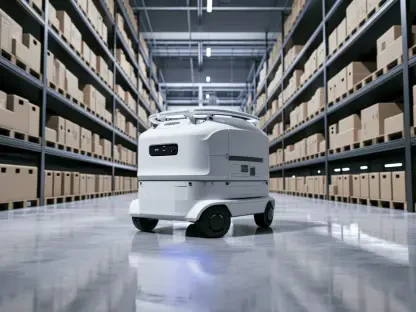As the retail industry continues to evolve, automation has steadily emerged as a pivotal factor in reshaping its landscape, particularly in the realms of warehouse operations and distribution centers. The relentless growth of e-commerce, coupled with shifting consumer expectations, has necessitated a profound transformation in how retailers manage their supply chains. Automation technologies now stand at the forefront of this evolution, offering solutions that enhance efficiency, resilience, and customer satisfaction. This article delves into the multifaceted impact that automation is having on the retail sector, examining key trends that underscore its importance.
The Rise of E-commerce and Its Impact on Retail Automation
E-commerce Growth and the Need for Speed
The surge in e-commerce has radically transformed consumer shopping habits, fostering an expectation for prompt and seamless services. This shift has placed immense pressure on retail operations to adapt and streamline their procedures, particularly in warehouses and distribution centers. Automation technologies have proven invaluable in maintaining pace with these demands, enabling retailers to expedite order processing and improve delivery times. Advanced systems like robotics and automated storage and retrieval systems (AS/RS) are crucial for meeting modern e-commerce requirements, providing efficient solutions for managing the increased volume of online orders.
The emphasis on speed is further reinforced by industry giants who have set high standards for quick delivery. Consequently, many retailers have invested heavily in automation to avoid falling behind. The adoption of automated technologies facilitates optimized workflows, minimizes error rates, and ensures a high throughput of goods. These benefits are paramount in an environment where delays or inaccuracies can lead to significant customer dissatisfaction and lost revenue. Automation is, therefore, no longer a mere advantage but a necessity for competitiveness in the bustling e-commerce-driven market.
Traditional Logistics Challenges in the Digital Age
As e-commerce escalates, traditional logistics models, predominantly reliant on human labor, are increasingly strained. These models struggle to keep up with the demands of a digital-first era, where consumers expect rapid and accurate order fulfillment. Manual processes are often hampered by human inefficiencies, leading to bottlenecks, errors, and delays. Automation offers a robust solution to these challenges by providing scalable, reliable alternatives to human-dependent systems.
Automated systems mitigate the risk of disruption that human factors introduce into logistics operations. With real-time monitoring and adaptive management capabilities, technologies such as Warehouse Management Systems (WMS) and Warehouse Execution Systems (WES) offer unparalleled oversight over inventory, workforce deployment, and order fulfillment. This integration empowers warehouses to meet the fluctuating demands associated with e-commerce, enhancing overall supply chain responsiveness.
Labor Market Dynamics and Technology
Addressing Labor Shortages with Automation
The retail sector faces a persistent challenge in labor shortages, particularly in roles within warehouses that are demanding and often undercompensated. This labor gap has been exacerbated by increasing competition for skilled workers and rising wages. To address this, automation is employed to carry out repetitive, labor-intensive tasks, reducing reliance on human labor while simultaneously increasing operational productivity.
Automation offers numerous benefits in workforce management, including supporting a more sustainable employment model. By delegating mundane tasks to machines, companies can allocate their personnel to more strategic and engaging roles, fostering employee satisfaction and retention. This shift not only spurs cost savings but also ensures that human resources are directed where their impact is more significant, further enhancing operational efficiency. Automation thus becomes a strategic ally in navigating the evolving labor market landscape.
Strategic Workforce Reallocation
As automation takes root in retail operations, companies can reassess their human resource strategies, focusing on value-added activities that enhance operational capabilities. The strategic reallocation of human talent to roles that require creativity, decision-making, and problem-solving engenders a more adaptive and forward-thinking workforce. Employees who are relieved of mundane tasks are free to contribute to functions that drive growth, such as product development, customer service, and market analysis.
This reallocation not only benefits the businesses themselves but also presents opportunities for employees to develop new skills and advance their careers. By investing in employee development alongside automation initiatives, retailers create a work environment that promotes innovation and fosters long-term success. The confluence of automation and strategic human resource management propels retail organizations towards achieving sustainable competitive advantage.
Technological Advancements in Warehouse Operations
Smart Warehouses and Their Role
Smart warehouses represent the pinnacle of modern supply chain sophistication, characterized by their adaptability and efficiency. These environments harness emerging technologies such as Artificial Intelligence (AI), the Internet of Things (IoT), and robotics to create self-sustaining ecosystems that optimize every aspect of warehouse operations. Through real-time data collection and analysis, smart warehouses can make autonomous decisions that maximize productivity and minimize waste.
The implementation of AI-driven systems allows smart warehouses to anticipate consumer demand shifts and dynamically adjust inventory levels. IoT devices facilitate seamless communications between machinery, ensuring cohesive operations across all warehouse stages. As a result, smart warehouses are capable of responding adeptly to market changes, maintaining service levels without compromise. This adaptability is indispensable in navigating the uncertainties of today’s retail environment.
The Role of Robotics and Artificial Intelligence
Robotics and AI have become integral to the evolution of warehouse operations, driving efficiency and operational excellence. Robots are adept at performing tasks that require precision and consistency, such as sorting, picking, and packing. Their deployment reduces error rates and accelerates order processing, which is critical for meeting the demands of fast-paced retail markets. AI complements these capabilities by enabling predictive analytics, optimizing resource allocation, and enhancing decision-making processes.
The synergy between robotics and AI results in a warehouse ecosystem that is not only efficient but also continually evolving. AI continuously learns from operational data, refining processes to improve performance over time. This ensures that warehouses remain at the cutting edge, capable of adapting to new trends and consumer expectations without requiring significant overhauls. For retailers, embracing these technologies translates into a more agile, cost-effective, and competitive operation.
Operational Resilience and Consumer Expectations
Ensuring Resilience in Retail Operations
Recent global challenges have underscored the critical need for operational resilience in the retail industry. External disruptions, whether pandemics or supply chain disruptions, can significantly impact business continuity. Automation provides a crucial buffer against these disruptions by reducing the reliance on human labor and building in the flexibility required to cope with unexpected changes. Retailers who harness automation are better positioned to maintain consistent service levels regardless of external pressures.
Automation enhances operational resilience by enabling rapid scaling of operations. Retailers can quickly ramp up or down based on shifting demand, ensuring that resources are optimally utilized at all times. This capability minimizes downtime and ensures that supply chains remain robust and responsive, even under duress. A commitment to automation, therefore, translates to greater stability and reliability, fostering trust among consumers and stakeholders alike.
Meeting Consumer Demands for Personalization
Today’s consumers demand personalized, expedient, and convenient shopping experiences, driving retailers to reevaluate their operations critically. Automation plays a pivotal role in fulfilling these expectations by enabling faster delivery times, improving order accuracy, and streamlining return processes. Technologies like AI and predictive analytics help retailers tailor offerings to individual preferences, enhancing customer satisfaction and fostering brand loyalty.
Automation streamlines the logistical intricacies associated with personalization, from managing complex inventories to accommodating multiple delivery options. As retailers refine their automation efforts, they can achieve greater precision in meeting consumer demands, thereby reinforcing their market position. This alignment with customer expectations is essential for thriving in a competitive landscape where consumer preferences evolve rapidly.
Automation as a Strategic Imperative
Automation: Beyond the Luxury to a Necessity
While automation was once considered a luxury or an optional investment, it has now become an indispensable component of a robust retail strategy. As retailers face a rapidly changing environment characterized by digital transformation, customer-centric business models, and evolving market dynamics, automation is crucial for maintaining a competitive edge. Companies are leveraging advanced robotics, AS/RS, and sophisticated software solutions to streamline operations and enhance customer experiences.
Automation provides strategic advantages beyond operational efficiency, offering valuable insights into consumer behavior and market trends. By leveraging these insights, retailers can make informed decisions about product offerings, marketing initiatives, and supply chain strategies. This data-driven approach enables companies to stay agile, adapt to emerging trends, and seize new opportunities, underscoring the importance of automation as a strategic imperative.
Implementing Automation for Retail Success
The successful integration of automation into retail operations requires a strategic approach that considers both technological and human factors. Retailers must evaluate their existing processes, identify areas for improvement, and select automation solutions that align with their business objectives. Collaboration with technology providers and industry experts can facilitate the seamless integration of new systems and ensure that automation initiatives deliver the desired outcomes.
Retailers must also cultivate a culture of innovation that embraces change and encourages continuous improvement. This cultural shift is essential for maximizing the benefits of automation and driving long-term success. Employees should be empowered with the necessary skills and resources to thrive in an automated environment, promoting a harmonious relationship between technology and human capital. By fostering a collaborative and forward-thinking atmosphere, retailers can unlock the full potential of automation and achieve sustainable growth.
Strategic Role of Automation in Retail’s Present and Future
As the retail industry undergoes continuous transformation, automation has emerged as a crucial component in revolutionizing warehouse operations and distribution centers. The surge of e-commerce and the dynamic shifts in consumer expectations have compelled retailers to radically rethink their supply chain management strategies. Automation technology is now at the forefront of this change, providing innovative solutions that significantly boost efficiency, enhance resilience, and improve overall customer satisfaction.
This evolution is largely driven by consumers’ increasing demand for faster delivery and seamless shopping experiences. Automation aids in streamlining processes by reducing human error and operational costs, all while speeding up the supply chain to meet these expanding demands. From robotic sorters that handle goods swiftly to AI systems predicting stock requirements, automation is firmly cementing its place in the retail ecosystem.
Moreover, it’s not just about improving operational efficiency. It’s also about building resilience against unforeseen market fluctuations and disruptions. By incorporating automation, retailers can better anticipate challenges, respond faster, and maintain their competitive edge. This article explores these multifaceted impacts of automation on the retail sector, highlighting key trends that emphasize its growing importance in ensuring the industry remains agile, efficient, and customer-centric in an ever-evolving market landscape.









